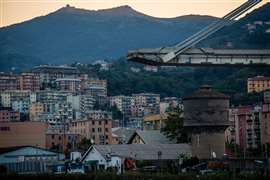Truss issue: Can AI solve the world’s ageing bridges crisis?
13 September 2024
A spate of high-profile and deadly failures and defects in recent years have brought the issue of bridge maintenance to the top of the news agenda. Lucy Barnard finds out how computer scientists are attempting to use AI to solve the ageing infrastructure crisis.
In a non-descript set of offices close to the University of Oxford, a group of computer scientists are planning to save the world.
“Our mission is to solve the world’s most important problems with artificial intelligence (AI),” says Tom Bartley, one of the newest recruits at Mind Foundry, a university spin out based around using AI for what it calls “high stakes applications.”
 AI generated image created with Ideogram
AI generated image created with Ideogram
The company, which was founded in 2016 by two professors of machine learning, has been turning its attention to one of the most pressing issues in the built environment today – that of assessing and repairing the thousands of ageing concrete and steel bridges around the world which are rapidly deteriorating due to climate change and pollution.
A spate of high-profile and deadly failures and defects in recent years have brought the issue of bridge maintenance to the top of the news agenda.
In 2018, 43 people were killed when a 200-metre section of viaduct which formed part of the 1960s-built, cable-stayed, reinforced concrete Morandi Bridge in Genoa, Italy, collapsed during a summer storm.
A year later, four people were injured when a 1950s-built concrete road bridge over the Salmyrsh near the Russian city of Orenburg partially collapsed in heavy rain.
In 2022, shortly before a planned visit by President Biden to promote his new Infrastructure Law, the 447-foot, 1970s-built Fern Hollow Creek bridge in Pittsburgh, Pennsylvania, collapsed 100 feet into the park below, injuring ten people.
In each of these cases, investigators concluded that inadequate inspection and maintenance contributed to the failure.
Bartley says that, although when they were built, many of these structures were expected to operate safely and reliably for over a hundred years, once bridges start to reach their half century, they start to require more intensive checks and maintenance.
“The road networks in Europe, in the United States, in Japan were built in the 1960s and 1970s around a boom in the use of motor vehicles,” he says. “Today, in these countries, the average age of our bridges is reaching 50 years and, just like people, once bridges reach the age of around fifty, deterioration increases. That means you need to be more proactive in the maintenance and management of these structures.”
Japan’s Ministry of Land, Infrastructure and Transportation, reckons that a third of the country’s 730,000 bridges are more than 50 years old. The US National Bridge Inventory finds that a quarter of the USA’s 623,000 bridges were built before 1960s, and the average age of existing bridges is around 42 years.
And that’s just the start. Experts are warning that as a combination of climate change driven weather extremes, pollution and heavy traffic flows are speeding up deterioration.
Climate change speeds up deterioration of bridges
“In the past we’ve been very passive in terms of the management of these structures,” Bartley adds. “We didn’t need to understand condition because they weren’t deteriorating. We’ve been able to just leave big lumps of concrete out in the world for decades.”
Bartley points out that despite a few high-profile failures, bridge collapses are rare, and most countries have strict inspection regime requirements where surveyors are sent to assess the integrity of each structure and close any bridges which could become a risk.
 The Morandi motorway bridge in Genoa, shortly after its collapse in 2018. Photo: Reuters/ Manuel Romano/NurPhoto.
The Morandi motorway bridge in Genoa, shortly after its collapse in 2018. Photo: Reuters/ Manuel Romano/NurPhoto.
However, it is only when you start looking at the data produced by these inspections that you start to get an idea of the scale of the problem which needs to be fixed.
According to an analysis of local council data by motoring group the RAC Foundation, 2,928 of the 73,208 bridges in Great Britain are classified as ‘substandard’ making them unable to carry the heaviest vehicles in 2024.
And the American Road & Transportation Builders Association (ARTBA) estimates that around 221,800 bridges across the USA currently stand in need of repair or replacement. Of these, around 42,067 have been classed as ‘structurally deficient’ and in poor condition.
“It’s impossible to fix all the bridges at the same time,” says Bartley. “There just aren’t enough resources.”
Mind Foundry’s proposed solution to this problem is to use artificial intelligence not only to help gain a deeper understanding the actual condition of each bridge but also to work out the best time to repair each of them individually at the exact point when where they would benefit the most from it.
Bartley says that currently bridge surveys often lack enough meaningful data for owners to be able to get a true idea of each bridge’s condition. This means that some bridges which are in fact perfectly serviceable get categorised as substandard, while others which are in urgent need of repair can be allowed to continue in service – sometimes with tragic consequences.
Inspections tend to fall into two main types: General inspections where a surveyor will get to a point within viewing distance of a bridge and jot down any critical issues that need further investigation; and detailed inspections, which tend to take place every six years or so which are within touching distance and require a more thorough investigation.
Surveyors are then required to give each structure a health rating of between one and five summing up its overall condition.
“The problem with both these cases is that the data they collect is really unstructured,” Bartley says. “It’s quite a subjective process and prone to human error. They’re working on a really narrow scale. Level one is perfect condition and level five means it has already failed so you’ve only really got three options. Inspectors are going out with clipboards and point-and-shoot cameras. It’s really difficult to know, given the size of a span, I’ve spotted a crack, is that the same crack someone else looked at two years ago or is it a different crack?”
Moreover, Bartley says, attempting to work out from these reports which repairs should be prioritised and how to allocate budgets, can be tricky – especially for large public bodies which often own hundreds of bridges.
 Mind Foundry’s mobile phone app in action. Image: Mind Foundry
Mind Foundry’s mobile phone app in action. Image: Mind Foundry
Instead, Mind Foundry is one of a number of companies looking to use an AI tool to detect and quantify bridge damage.
At the heart of the new tool is a mobile phone app through which inspection contractors or municipal staff can take photographs of bridges and upload them.
Trained using photos and inspection reports from around 300 bridges in Susono city in Japan, the system then analyses the images to detect and quantify damage – removing subjectivity from the process and enabling greater consistency.
Human experts can then look at a more detailed set of results in the round in order to judge each bridge’s condition and decide how to spend municipal budgets more effectively.
“Basically, the app is an augmented camera,” says Bartley. “It plots where the camera was and what part of the structure you were looking at. You can mark up on the photo. This bit is a crack. Here is some spoiling that I saw. Here are some notes about it. And then when you get back to the office, you can upload historic photos, and it will automatically check against previous photos as to whether the defects have got worse or not.”
 Tom Bartley, director of civil infrastructure at Mind Foundry. Photo: Mind Foundry
Tom Bartley, director of civil infrastructure at Mind Foundry. Photo: Mind Foundry
Unlike other firms looking to use AI to assess bridge condition such as Canada-based Niricson and New Zealand-based Beca, Mind Foundry’s app is designed to be used on a large volume of structures and not the high-profile iconic bridges which are often already highly monitored using sensors and drones.
Bartley will not be drawn on whether such technology would have enabled municipalities to avoid disasters such as the 2018 Genoa Bridge collapse but points out that providing experts with more accurate data about the true condition of thousands of structures can help to highlight cases where there is a major defect.
What are deterioration pathways?
But where the artificial intelligence really comes into its own, Bartley says, is by looking at all of the bridge defects across a portfolio and working out at exactly which point to carry out repairs so that they are performed at the point when they would benefit most and in the most cost-effective manner.
“We call it deterioration pathways,” Bartley says. “If you’ve got metal work you want to keep that painted. If you don’t keep it painted, it will start to rust. If it starts to rust, it will then start to have section loss, and if you start to have section loss, you start to have member loss. Each step in that deterioration pathway is an order of magnitude more cost to repair. But what you don’t want to do is just see a little bit of rust and go ahead with a full repair – that’s a really expensive way of doing it.”
“Instead, you want to monitor the deterioration in that pathway and catch it just before it goes to failure,” he says. “Part of where the AI will really get smart is working out the optimal time to fix this issue. We estimate that around a third of the life cycle costs of bridge management could be saved if we got the timing of the intervention right.”
But what happens if the AI gets it wrong? At the end of the day, Bartley says that the app is not designed to replace human decision making, simply to assist it, leaving the ultimate choices of when and how to implement maintenance budgets to trained human experts.
“We make it very clear that this is a human-AI collaboration,” Bartley says. “Ultimately the risk needs to lie with the bridge manager who is actually out there in the world and understands that this is about augmenting inspections rather than replacing human decisions. I’m sure we’ve got a lot of discovery to do along the way, but we can’t just hand over the responsibility to the computer. We need to do this in a way that is collaborative.”
STAY CONNECTED



Receive the information you need when you need it through our world-leading magazines, newsletters and daily briefings.
CONNECT WITH THE TEAM








